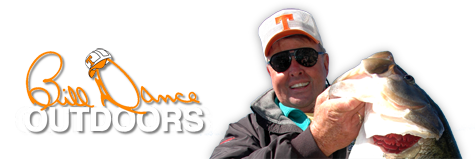Turnovers sometimes apply to anglers, not apples
Posted: October 8th, 2014 by Bill Dance
You know, when you hear the word “turnover” in the fishing world (rather than at the bakery…apple turnover, anyone?), it is usually seen as a big negative. But that isn’t necessarily the case. And honestly, if you look at anything first considered bad, you can almost always find some “good” somewhere.
 This is the case with lake turnovers, too. In fact, if it weren’t for a complete turnover twice a year, most lakes and ponds would become stagnant because of a continued buildup of oxygen-depleted water. As water temperatures drop, water becomes heavier and denser. Maximum density is reached when the water is 39.2 degrees F. Colder than that, water becomes lighter. That’s why ice floats on the surface. If water didn’t become less dense as it freezes, the ice would settle to the bottom of northern lakes and destroy aquatic life.
This is the case with lake turnovers, too. In fact, if it weren’t for a complete turnover twice a year, most lakes and ponds would become stagnant because of a continued buildup of oxygen-depleted water. As water temperatures drop, water becomes heavier and denser. Maximum density is reached when the water is 39.2 degrees F. Colder than that, water becomes lighter. That’s why ice floats on the surface. If water didn’t become less dense as it freezes, the ice would settle to the bottom of northern lakes and destroy aquatic life.
To trace the cycle: In the fall of each year, water temperatures drop and the heavier water falls to the bottom. This forces the bottom waters to the top, where they once again become re-oxygenated; when this happens, the lake is said to “turn over.” During this brief period, all levels of the lake have enough oxygen to support life, and bass could be scattered throughout any of the levels.
If the lake is far enough north for the water to reach 39.2 degrees or colder, the 39.2 degree-water will remain on the bottom and ice might coat the lake. The water in the intermediate levels will range between 39.2 degrees and 32 degrees.
In the spring, the process reverses itself. The ice melts, and as the surface waters warm to 39.2 degrees, they become heavier than the water below them and sink to the bottom, once again forcing the bottom water to the top. The sun continues to warm the water and many lakes then become stratified.
On the basis of water temperature, three distinct layers form in a lake. The cold bottom layer is known as the hypolimnion. The warmer surface region is called the epilimnion, and there is a transitional zone between the two called the thermocline. By definition, water temperatures in the thermocline change 0.5 degrees for every foot of depth. The thermocline is a relatively narrow band of water and can be found easily with a thermometer because of this rapid temperature change.
During the summer, the hypolimnion or bottom layer becomes devoid of oxygen; and therefore, fish cannot penetrate this zone. That means all the fish in the lake will be in the upper surface zone (epilimnion) or in the transitional zone (thermocline). Temperature causes this phenomenon, but oxygen is the governing factor concerning the distribution of fish.
Well, that is the science of turnovers. It’s just another natural phenomenon we anglers have to adjust to; the fish certainly do, so we should too. I think if you know the science behind the behavior of fish, and what goes on in their environments; it stands to make you a better fisherman while also helping us form much better plans when it comes to catching ‘em. How often do we go fishing and have to spend some time figuring out? The more we know, the better the battle plan!

